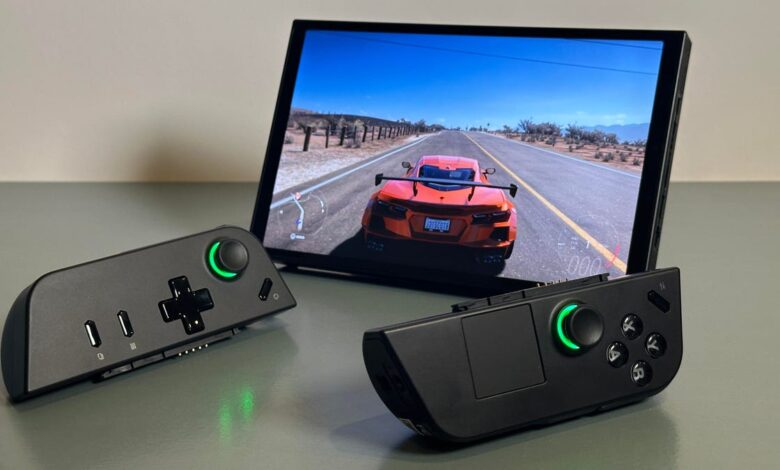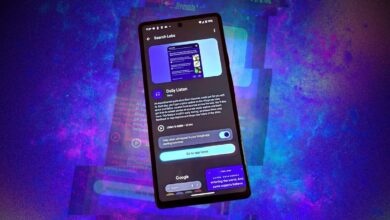Lenovo Legion Go Review: Maybe Just Get a Steam Deck

Pros
- Large 8.8-inch display
- Windows OS means multiple game store support
- Detachable wireless controllers
- Built-in kickstand
Cons
- Game support is unpredictable
- Windows OS feels messy and unoptimized
- Loud fan, mediocre battery life
- Heavier than Steam Deck
The future of handheld gaming has never looked brighter. The Nintendo Switch may get a whole new upgrade next year, but it still plays great now. Indie handhelds are everywhere. And then there’s the Steam Deck, which made great handheld PC gaming a reality. Now Windows-ready handhelds are popping up everywhere, too. Case in point: the Lenovo Legion Go.
This is exactly what I expected back in 2017, when the Switch made its stunning debut. It’s just taken a while to get here (I remember the first PC game handheld I reviewed way back in 2013, the Razer Edge, and having similar future feelings). But Lenovo’s massive kitchen-sink handheld solution is a classic example of how much work the Windows side of handheld gaming still needs.
Watch this: Steam Deck OLED vs. Lenovo Legion Go: How to Pick a PC Handheld Gaming System
Valve just upgraded its Steam Deck with a bunch of useful improvements, better battery life and a slightly larger OLED display. It runs many Steam games really well. Meanwhile, Lenovo’s proposition with Legion Go is full Windows 11 for access to Steam, Microsoft’s games and apps, Epic and anything else, plus an even larger display than the Steam Deck, a faster AMD processor, detachable controllers like the Switch, an adjustable kickstand and a built-in optical mouse and scroll wheel on the right controller to boot.
In theory, the Go is great. In practice, it frequently drove me crazy and made me realize how much more I prefer the Steam Deck. Windows gaming handhelds are still in their early days, and the Legion Go is an entry you’ll probably want to skip for now.
The Lenovo Legion Go has removable controllers and a kickstand in a Windows game handheld — which sounds great, but the execution is mixed.
Good stuff: The display, kickstand and controllers
Before I get critical, the Legion Go has some perks. Its 8.8-inch display is great for seeing games in full detail despite making it a huge 1.8-pound beast of a handheld that feels more like a small laptop at times. Even though it’s not an OLED panel, it’s vivid and sharp. The 2,560×1,600-pixel resolution is bigger and more detailed than the Steam Deck’s 1,280×800 display. It matters particularly for RPGs and games with lots of text that are designed for larger laptops and monitors. I sometimes squint with Steam Deck, but with the Legion Go it all looks good. But I found myself downscaling the resolution when playing some games to allow for better performance.
Standing the Legion Go up on a table with its kickstand is great. Also, Elden Ring looks really nice on it.
The built-in kickstand and snap-off wireless controllers add a Nintendo Switch-like tabletop mode play option that, on a device this big, actually makes a lot of sense. Sitting back a bit and playing games like Elden Ring or Forza Horizon 5 is fun and gives my arms a rest. The Legion Go’s button-studded controllers feel chunky and sometimes confusing, especially since the right controller flips button arrangements in the grip and has a scroll wheel (!) for its FPS-focused mouse function. The controllers can’t be charged up except when popped into the Legion Go via side pin connectors. But I love the effort here, especially against the Steam Deck’s all-in-one fixed handheld design.
The wireless Legion Go controllers are complex, but they remind me of what I’d hoped the Steam Deck would have.
Bad stuff: Windows, game compatibility
I’m not a PC gamer, but I love handheld gaming devices and have played on them for decades. The Legion Go isn’t a handheld game system to me — it’s a handheld Windows PC. The capabilities of the Legion Go are potentially infinite in that regard, since you could connect it to a monitor, add a keyboard and mouse and run basically any Windows app. Your mileage there would certainly vary, but the Legion Go’s specs are solid: 16GB of RAM, two USB 4.0 ports, a microSD card reader and the AMD Ryzen Z1 Extreme processor (similar to what powers Asus’ ROG Ally Windows gaming handheld, which arrived earlier this year).
The Legion Go can run games from multiple game stores — Game Pass, Steam, whatever. The only problem is, it’s hard to tell what will actually run well… or run at all.
The Legion Go can run any PC game store with its Windows flexibility. The Legion Go launcher, an interface app that consolidates your game library and links to other apps like Steam and Microsoft’s Xbox app, points out the possibilities. I liked being able to load up Steam games and Microsoft Game Pass games, which can’t easily be done on Steam Deck. I found plenty of weird problems, though.
Besides a slew of Windows spam stuff like security alert pop-ups, I found some games ran poorly and others didn’t run at all, much like any underpowered gaming PC would. I was excited to play Madden 24, for example, but the game was slow and choppy for me, no matter how many settings I tried to tweak. Similarly, Ratchet & Clank: A Rift Apart, which runs great on Steam Deck, kept crashing due to a “lack of video memory.”
If you enter FPS mode, remember to switch the controller back afterward!
On the other hand, Elden Ring ran as well as it does on the Steam Deck, but larger. Forza Horizon 5 looked great, too. But it’s a trial-and-error process of finding games that work, adjusting settings and even seeing if the proper drivers are installed. I had to go to Lenovo’s site to make sure the Legion Go had the proper drivers, and even then I wasn’t entirely sure.
Basically, I was thrown way out of my comfort zone. Windows 11 isn’t made for small-screened game handhelds, and Microsoft seems to have done none of the work to try to make devices like the Legion Go fun to use. Lenovo has done its best via its software, but it feels like a glued-on solution. The Steam Deck is comforting by comparison: a dedicated OS linked to Steam, games that are clearly marked as being Steam Deck-ready, and software updates that run without going on a scavenger hunt. I’ve had far more luck running games smoothly on the OLED Steam Deck than on the Legion Go.
The Legion Go is a full Windows device and can run multiple apps. You could use this as a computer, with the included mouse/controller.
Weird things, too
The Legion Go’s controllers feel good button-wise, but they’re bulkier than the Steam Deck’s, and the Steam Deck’s double touchpads with their haptics are better designed. The Legion Go’s right controller has a small switch on the bottom and an optical sensor: Flip it, and suddenly you have a hand-grip mouse, meant to be a FPS-style PC game control setup. There’s a magnetic docking disc that’s included, which the right stick drops into. In this mode, you could prop the Legion Go on a desk and use this as a mouse to click around Windows, or yes, try playing a game. I’d imagine dedicated mouse gamers would just bring their own and set it up, though it’s a fun perk.
I do love the solid kickstand, which helps because this is a heavy handheld.
But I also had moments where the Go’s optical mouse-mode controller seemed to be active even when the switch wasn’t flipped. I also had occasions where the controllers didn’t seem to activate when undocked.
The Legion Go’s cooling fans are also quite loud. They’re adjustable, but even in the quietest setting they whirred a lot more than the Steam Deck’s ever have. The Legion Go’s battery life, despite having a 49-watt-hour battery, drained faster than I would have liked. While recording my video for the Legion Go one afternoon at CNET, the battery got to 50% a lot faster than the Steam Deck over the same span, around a couple of hours.
The Lenovo Legion Go (bottom) vs. the OLED display Steam Deck (top). The Legion Go has the larger screen, but the Steam Deck is much smaller and lighter, and has a more polished, handheld-focused OS for Steam game support.
If you really want a PC game handheld right now, go with Steam Deck
You could be a tinkerer who likes the openness and specs of the Legion Go, and enjoy the challenge. To me it’s a project I didn’t enjoy. The Windows gaming handheld space is likely to keep growing fast in the next couple of years, spurred by more compact chips that companies like AMD are already making, plus a bigger wave of handheld-optimized games, thanks to Valve’s Steam Deck efforts along with the tendency for manufacturers to follow a trend.
All we need now is for Microsoft to finally commit to making Windows, and its Xbox app games, feel more native to handhelds like these. I want an experience that feels less kludgy and more intentionally integrated — and that runs easily and reliably. That isn’t the experience you’ll get right now with the Lenovo Legion Go, but it’s a great demonstration that, hey, the hardware’s ready. We’re just waiting on the software to catch up.






